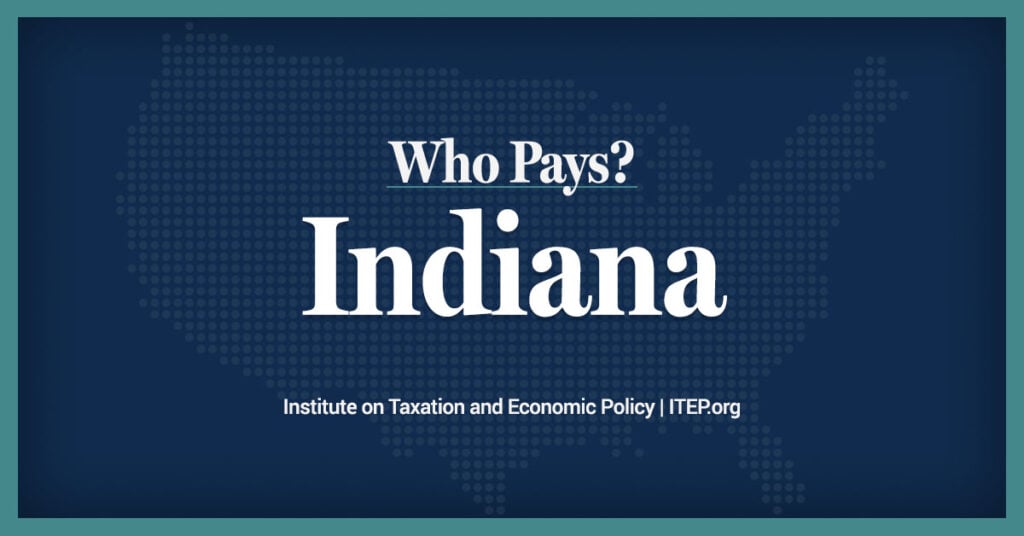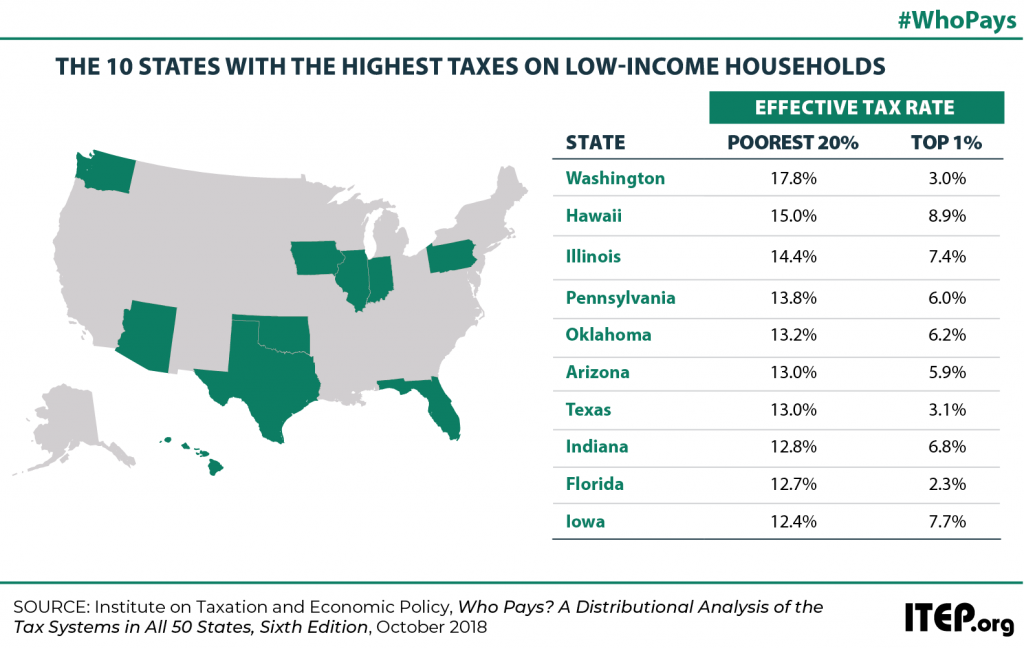Today ITEP State Policy Analyst Neva Butkus presented to the Indiana State and Local Tax Review Task Force.
For a related blog from Neva, click here. For her slide deck, click here.
Good morning members of the State and Local Tax Review Task Force,
Thank you for providing me the opportunity to share ITEP’s findings regarding Indiana’s tax system. My name is Neva Butkus and I am a state policy analyst with the Institute on Taxation and Economic Policy, also known as ITEP. We are a non-partisan, nonprofit research organization that analyzes and provides data-driven recommendations on state, local and federal tax policy. Our unique value add is our microsimulation tax model that allows us to analyze how taxes affect people at various levels of income and wealth.
We provide these analyses on a state-by-state basis, and as part of larger 50-state reports, including our flagship Who Pays? report which is the only distributional analysis of tax systems in all 50 states and the District of Columbia. It assesses tax equity by measuring the effective state and local tax rates paid by all income groups. Our most recent report on this topic found that the vast majority of state and local tax systems are inequitable and upside-down, meaning that they take a greater share of income from low- and middle-income families than from the wealthy – and Indiana is no exception. So most states – including Indiana – are allowing their wealthiest residents to get by paying lower tax rates than those faced by the middle-class and by families living at or near the poverty line.
My presentation today will focus on Indiana’s current tax structure and the impact that further reductions or complete elimination of the state personal income tax would have on the residents of your state. Such a shift would ensure that the poor and working class would pay even more as a share of income than the state’s wealthiest, and that’s on top of limiting the state’s ability to raise adequate revenue needed for key public investments. If your tax code is poorly designed or if tax cutting is prioritized at the expense of the state’s needs, then the money just won’t be there – either today or in the future. Meaningful investment in Indiana’s future requires a smart, and fair, tax code that recognizes current economic realities and that can raise a sustainable stream of funding for the long haul from those most able to pay.
In ITEP’s most recent edition of Who Pays?, we tally up all the major taxes collected by Indiana, and by every other state, and assess how those taxes are impacting people at different income levels. The study does not just focus on income taxes, but includes sales taxes, property taxes, business taxes, and gas and alcohol taxes as well (to name a few).
What we found in Indiana is that when you take all state and local taxes into account, Hoosiers in the bottom 20 percent of the income scale – making $18,800 or less per year – pay 12.8 percent of their income in state and local taxes. Meanwhile, a household in the top 1 percent in Indiana – making upwards of $436,000 per year – pays almost half of that, as a share of their income in Indiana taxes, just 6.8 percent. We have an updated edition of this report underway that will incorporate the state’s most recent tax changes but should not drastically alter this finding.
Indiana has what we refer to as a deeply regressive tax system, which is when a state asks its lowest- and middle-income families to contribute a larger share of their income than the state’s wealthiest towards funding the services all Hoosiers, and Indiana’s economy, need to thrive like education, healthcare, and infrastructure. Increasingly, regressive state and local tax systems have contributed to the soaring level of inequality in both income and wealth across the nation. Because of this it’s more vital than ever than those families experiencing economic success contribute to funding the education systems, infrastructure networks, and countless other services that have made their wealth possible so that every Hoosier family – regardless of zip code, county, or income – has a chance for success in the years ahead.
Drivers of this regressivity include Indiana’s 7 percent sales tax rate, the second highest state rate in the nation. By necessity, low- and moderate-income households spend nearly every dollar they earn to meet their basic needs. Because most, if not all, of their paycheck goes to food, housing, gas for their car, childcare, school supplies for their kids, and the like, sales and excise taxes take up an enormous portion of their take-home pay. This is why low and middle-income households in Indiana spend four-to-seven times more of their income on consumption (sales and excise) taxes than Indiana’s wealthiest households.
Most states that levy consumption taxes also levy income taxes which can help level out the regressivity of their sales, excise and property taxes. Individual income taxes are most effective at providing some balance when they are designed with a graduated structure, have multiple tiers, and ask more from the state’s highest earners. This design feature that is based on one’s ability to pay counteracts the state and local taxes that ask the most of the state’s low- and middle-income earners. Well-designed corporate income taxes can also make state tax systems more progressive while ensuring large, multinational corporations pay their fair share, but Indiana’s flat corporate income tax rate of 4.9 percent is one of the lowest in the nation.
Indiana’s current individual income tax rate of 3.15% is set to be reduced to 2.9% by 2027, which will make Indiana’s tax system more regressive while also ensuring that important revenue, exceeding $850 million, is drained from state coffers each year.
Of this $850 million, our 2024 analyses show that the state’s low-income households in our bottom quintile making less than $26,000 a year would see a $31 tax reduction. Middle-class households do not fare much better, as a household making an average of $65,000 a year would only see a tax cut of $160. That is in comparison to the nearly $3,750 boon experienced by households in the top 1 percent of earners who bring home an average annual salary of $1.5 million. Moreover, the top 20 percent of earners with average annual incomes of $273,000 will receive well over half (58 percent) of the overall tax reduction. By the numbers, this was not a middle-class tax cut, as the richest Hoosiers are benefitting the most.
The current discussion regarding complete income tax elimination would double down on those impacts and cost the state nearly $7.9 billion a year. This does not include potentially prohibiting local governments from choosing to enact an income tax, which brings in nearly an additional $4 billion in annual revenue. If lawmakers chose to eliminate Indiana’s personal income tax today, a household in the top 1 percent of earners – with an average annual income of $1.5 million – would receive a tax cut of nearly $34,000. A household in the bottom 20 percent making under $26,000 a year would see a $203 average tax cut. To put this another way, millionaires in Indiana would receive an average of $34,000 back in tax cuts while more than a quarter of Hoosier households do not even earn $34,000 in a year.
What’s more, decades of research and experience shows that tax cuts do not pay for themselves, and current state surpluses are temporary in nature and will eventually fade. So it’s inevitable that states currently slashing their personal income taxes will be confronted with two options. The first is to make drastic, permanent cuts to public services. These cuts could be potentially devastating to Indiana’s state economy as strong higher education, exceptional K-12 schools, accessible childcare, and modern infrastructure are crucial to any state’s ability to attract, grow, and retain talent. The other option, which we see in many states, is that rather than deeply cutting services lawmakers look to make up lost revenue with taxes that ask more of low- and middle-income families. As demonstrated previously in this presentation, consumption taxes (sales and excise taxes) are regressive and do just that, asking the most of your lowest earning residents and hard-working middle-class Hoosiers.
Using ITEP’s tax model, we estimated what it would look like to use the state’s sales tax to replace revenue lost from eliminating the state income tax. If the state chose to replace just 50 percent of lost income tax revenue with a sales tax increase, the state sales tax rate would need rise to 9.5 percent – which would be the highest sales tax rate in the nation and nearly the highest combined state and local sales tax rate (when comparing to states that also levy a local sales tax).
Eliminating the individual income tax while replacing 50 percent of the tax revenue with a higher sales tax rate would increase the already regressive structure of Indiana’s tax system. A middle-class household making $65,000 annually would see a tax cut of $605, around one-fiftieth the size of a household in the top 1 percent. The average Hoosier in the bottom 20% would end up with a tax increase due to the regressivity of state sales taxes. Meanwhile, the wealthiest Hoosiers would benefit from a near $30,000 tax cut.
This tax change would result in households in the bottom 20 percent of income earners contributing an additional .4 percent of their income in taxes, while millionaires would contribute 2 percent less of their income in taxes. Middle-income Hoosiers would receive a small tax cut, but the wealthiest households see the largest tax cut by far both numerically and as a percentage of their income.
Instead of seeking deep cuts to the income tax, or even getting rid of it altogether, I encourage members of this committee to focus on making Indiana’s tax system less regressive while ensuring that the state makes meaningful investments in Indiana’s future. There are key ways to achieve these goals with equity in mind. Lawmakers could consider closing corporate loopholes that drain public resources and do little to benefit residents of Indiana; restructuring the state’s income tax to ensure that those with the most ability to pay do so; raising needed revenue through an estate or inheritance tax, both designed to limit the transfer of wealth and reduce inequality; or creating refundable tax credits – beyond the state’s EITC – to help mitigate the fact that the state’s low- and middle-income families pay the most in state and local taxes as a share of their income.
There is no evidence that lower income taxes, or lower taxes in general, drive economic growth. Indiana, with its historically low rate, has not outpaced its neighbors in the Midwest. Instead, states must prioritize funding the things that we know are building blocks of a strong economy. Good schools and universities, high-quality healthcare, accessible and affordable childcare, housing, and infrastructure. These are the tools that will not only attract people to Indiana but will best position Hoosier families to have the tools they need to build long, prosperous lives.
Thank you for your time. I am happy to answer any questions from the committee.





